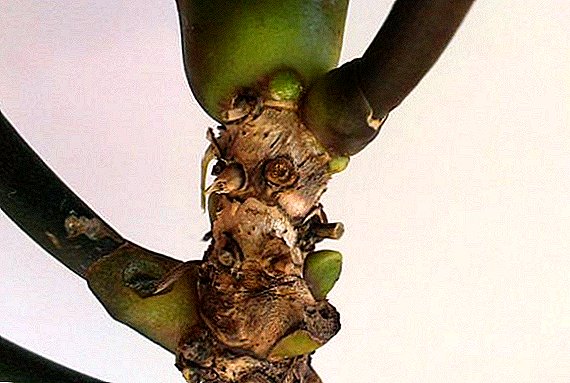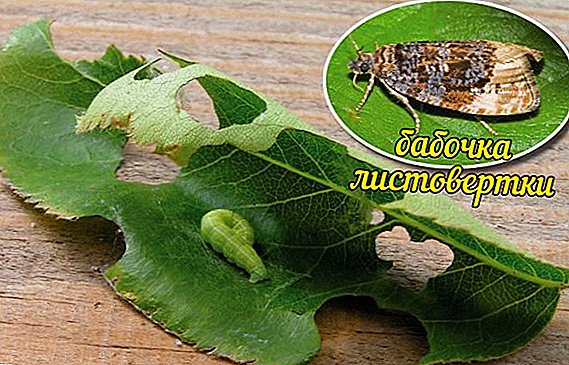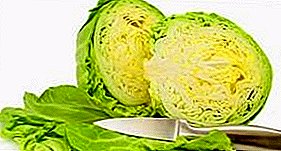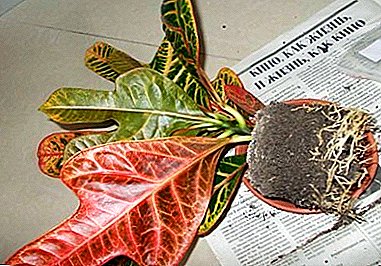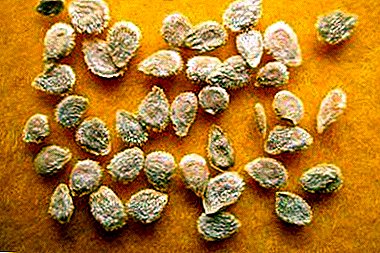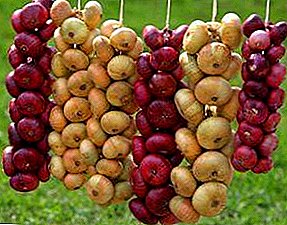 Alstroemeria - beautiful flowering plant that came to us from South America. In the Russian conversation you can find another name - Alstroemeria.
Alstroemeria - beautiful flowering plant that came to us from South America. In the Russian conversation you can find another name - Alstroemeria.
In nature, there are more than 200 species of beautiful flower. Alstroemeria is an ornamental plant, it is grown at home, in greenhouses, occasionally as a garden plant.
The flower can often be found in bouquets, as it can please for a long time in a vase with its beauty. He is boldly attributed to one of the most beautiful perennial plants.
The only negative point of a flower is that its petals fall pretty quickly.. How to grow alstroemeria and how to take care of it is described in detail in this article.
Did you know? In the tents selling flowers, there is an inscription that Alstroemeria is “a hybrid of lilies and orchids,” but it is not true. In fact, it belongs to the family of tuberous herbaceous plants.
Planting Alstroemeria seeds for seedlings
 When growing alstroemeria with the help of seeds, flowering occurs in about 2 years. In some cases, the period may take up to 3 years.
When growing alstroemeria with the help of seeds, flowering occurs in about 2 years. In some cases, the period may take up to 3 years.
For planting a flower you need to prepare the ground, sunny, but without direct rays place. If you correctly follow all the rules when planting and courtship, the flower will delight with its bloom all summer.
When to plant
Planting flower seeds in pots is best in early spring. The end of February-beginning of March is the ideal time for the beginning of flower growth. But for different hybrids of the plant is selected its time of planting. It is better to choose a cloudy, warm day for planting seedlings.
Soil for Alstroemeria
Soil for alstromeria need to prepare in advance. To do this, take 2/3 of leafy humus, and fill the rest of the tank with turfy ground. The turf ground well passes air and water, possesses good acidity which the flower needs.
Mix thoroughly, and then you can safely engage in planting seeds. When planting, it is better not to use chemical fertilizers and growth stimulants.
Landing procedure
 After you have prepared the soil for the flower, you can start planting. In the pot or other container that you use, do not forget to put the drainage on the bottom. Fine gravel or pebbles can be used.
After you have prepared the soil for the flower, you can start planting. In the pot or other container that you use, do not forget to put the drainage on the bottom. Fine gravel or pebbles can be used.
Place the seeds of the plant on the ground and slightly press down so that they go deep into two heights of your growth. Sprinkle the top with soil, then pour and cover the pot with plastic wrap.
The procedure for planting alstroemeria seedlings on this completed, and you can send flowers to the stratification.
Important! During flowering, alstroemeria can release substances that cause irritation to the skin.
Seed stratification
Alstroemeria stratification begins immediately after landing. By stratification is meant aging the seeds at a certain temperature to accelerate their growth.
Planted seeds covered with foil are placed in an environment with a temperature from +2 to + 5 °. There, the flower is aged for about 20 days.
Some seeds may germinate more slowly, and a sprout will appear after 30 days. Such a low temperature contributes to faster seed germination. Stratification ends when a young stalk is visible.
Planting seedlings in open ground
 To plant sprouted seeds are best near the end of May. At this time, the risk of night frost drops completely, and the sprouts will not be threatened. For planting, it is recommended to choose a warm day, but without the hot sun, when the earth dries out enough.
To plant sprouted seeds are best near the end of May. At this time, the risk of night frost drops completely, and the sprouts will not be threatened. For planting, it is recommended to choose a warm day, but without the hot sun, when the earth dries out enough.
We dig holes at a distance of about 30 cm from each other. The depth of the fossa is no more than 25 cm. At the bottom of the hole we place a layer of up to 10 cm prepared organic compost. We deepen slightly the root of the sprout and cover the hole with earth.
Sprinkle with a few centimeters of mulch on top. It will help to fight with the germination of weeds and for a long time to retain moisture in itself. But do not completely hide the sprout under the mulch. Then the entire landing zone is watered abundantly so that the water reaches the very bottom of the hole.
Important! Under no circumstances should we overheat the root above 22 °. After exposure to this temperature, rhizomes may begin to die.
Proper care - a plentiful bloom
To Alstroemeria pleased you with the beauty of its bloom, you need to properly and promptly care for it. At each stage of flower growth requires a separate approach. Regular watering and timely fertilizing fertilizer - the key to successful flower growth.
Despite the layer of mulch, the weeds will still break through, you need to constantly weed the beds. Alstroemeria blooms in the first year of planting, after about 2 months, and blooms until the end of August. After flowering, we cut off the peduncle, leaving about 7 cm of the stem.
 Organic feeding can be done no more than twice a year, in spring and summer. In winter, the plant is cut off the upper part and dug together with the root. And if the winter period is not so frosty, and it is older than two years, you can fill the landing site with dry leaves.
Organic feeding can be done no more than twice a year, in spring and summer. In winter, the plant is cut off the upper part and dug together with the root. And if the winter period is not so frosty, and it is older than two years, you can fill the landing site with dry leaves.
How to care for the soil
The soil on which alstromeria grows should be moderately acidic, with a small amount of fertilizer. The soil needs regular watering, the moisture should penetrate 3 cm deep. When the soil dries, the shoots will not die, but the plant will lose its shape and charm.
During the growth of the bushes, the soil should be more saturated with nitrogen, and during budding - with potassium. It is better to use a balanced fertilizer containing potassium, nitrogen and magnesium. Fertilization of alstroemeria fertilizer should occur in spring and summer.
How to prolong flowering
The flowering of Alstroemeria largely depends on the care and fertilization of the soil. But in order to observe the colorful flowering buds, the plant must be subjected pruning.
After planting, the flower quickly shoots many shoots, about 75 - 110 shoots. They must be trimmed every month. Removed weak and thin stems. In general, about a third of the entire shrub is cut off, which gives the rest of the stems to bloom longer and brighter.
When to dig and store rhizomes
In the first year of flowering of alstroemeria, she may not survive the winter, and foliated or twig flooring from above will not help her. Rhizomes with stems need to dig and 2, and 3 years, until the plant is thoroughly strengthened.
In the autumn, when the period of night frost begins, it is time to dig out the flowers. To do this, we prune the stems to a length of about 20 cm. We take a pitchfork and carefully dig it in order not to damage the root.
 The excavated root is left in the ground, only slightly clearing it. Earthen room should be slightly dried, so that during winter storage the roots do not rot. Keep the roots in the basement or cellar, or in another place with a temperature not higher than 5 °.
The excavated root is left in the ground, only slightly clearing it. Earthen room should be slightly dried, so that during winter storage the roots do not rot. Keep the roots in the basement or cellar, or in another place with a temperature not higher than 5 °.
Did you know? If your girl is allergic, give her a bouquet of alstroemeria, these flowers are odorless and do not cause allergic reactions.
Alstroemeria in landscape design
Such a beautiful and delicate flower, like Alstroemeria, can become the main decoration of your front garden, be a beautiful background, or exist in harmony with many beautiful inhabitants of the landscape. Due to the large height (in some cases up to 1.7 meters) and bright various colors: from pink to purple, it looks great as a background for roses.
The union of the fragility of Alstroemeria and powerful roses is one of the most popular plantations. Also a good combination with them is the planting of chrysanthemums. Especially if the landing of both varieties made in soft colors.
And in a palette with gerberas use orange and pink tones. Alstroemeria can be used in a dominant position in your flower bed. Only then in the opponents of the flower you need to choose more stunted plants such as stonecrop or iris. Dreaming, you can achieve harmony in your area.
Did you know? A bouquet with cut flowers can stand up to one month!
Methods for breeding alstroemeria
 Alstroemeria reproduces in 2 ways: by seeds and division of rhizomes. In both cases, the flowers should be disturbed in the spring, before the plant begins to grow. If you disturb the fertile shoots during growth, they will no longer bloom this year.
Alstroemeria reproduces in 2 ways: by seeds and division of rhizomes. In both cases, the flowers should be disturbed in the spring, before the plant begins to grow. If you disturb the fertile shoots during growth, they will no longer bloom this year.
Seeds can be harvested on their own, and they can store their fruitful function for up to 4 years. The roots are also best shared in the spring.
Division of rhizomes
The division of the rhizomes should be done in early spring, before the plant begins to grow. It is best to choose thicker rhizomes, too thin can give weak shoots, or not climb. For digging it is better to use forks, so as not to damage the rhizomes.
The rhizomes are cut into a maximum of 3 parts, they must all be healthy, well developed and have up to 10 eyes. To prevent the entry of microbes, process sections with a weak solution of potassium permanganate.
 We plant roots about 4 pieces per square meter. The depth of the hole directly depends on the size of the root, but usually they are no more than 30 cm. After planting, we cover the ground with compost and water. If the roots are well developed, flowering stems will appear next year.
We plant roots about 4 pieces per square meter. The depth of the hole directly depends on the size of the root, but usually they are no more than 30 cm. After planting, we cover the ground with compost and water. If the roots are well developed, flowering stems will appear next year.
Seeds
Growing alstroemeria from seeds is possible both in pots for seedlings, and immediately into the ground. Only some varieties of Alstroemeria can survive the winter period, so for 2-3 years they will need to be dug out for the winter.
In order for the seeds to germinate, they need stratification, aging in a special soil at certain temperatures, before the plant sprouts. Details of this point is described above in the article.
The resistance of alstroemeria to pests and diseases: how to deal with them in case of defeat of the flower
 Despite the tenderness and fragility of the flower, it is quite resistant to attacks of pests and diseases. If the ground has poor drainage or if the air is too humid, then alstroemeria can get sick. gray rot.
Despite the tenderness and fragility of the flower, it is quite resistant to attacks of pests and diseases. If the ground has poor drainage or if the air is too humid, then alstroemeria can get sick. gray rot.
It can also be during a heavy rainy season. To save the plant, you need process it with a base solutionby repeating it after 3 weeks.
The main pests of alstromeria are slugs, spider mites, caterpillars and leaf-eating beetles. But if you preliminarily and regularly treat alstromeria with such effective drugs as Karbofos, Aktara, or similar means, the pests of the plant are not terrible.
The beauty of the flower is admired throughout the world, so you can see it anywhere in the world. You can also grow alstormeria in your garden, observing simple rules of care.


